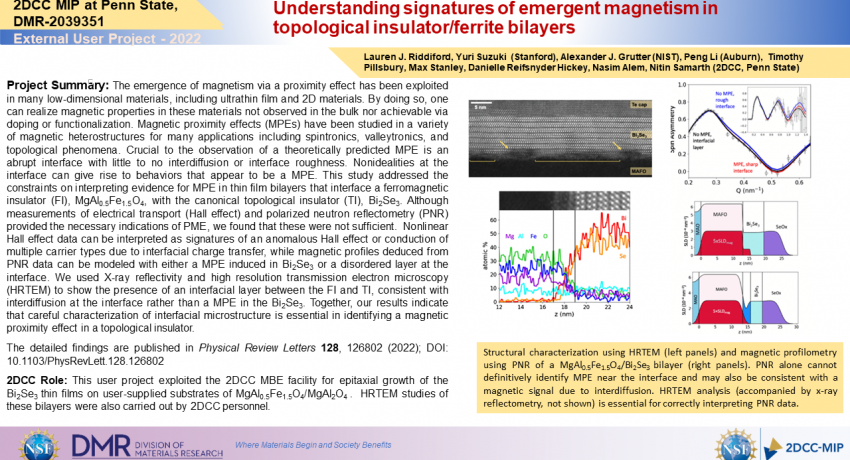What Has Been Achieved:
This paper reported a comprehensive study of magnetic proximity effect (MPE) in bilayers that interface a topological insulator (Bi2Se3) with an insulating ferromagnet {MgAl0.5Fe1.5O4), demonstrating the need for careful interpretation of polarized neutron reflectometry and anomalous effect data that are often used to show purported evidence of MPE.
Importance of the Achievement:
A precise understanding of MPE is important from a fundamental aspect, particularly in TIs interfaced with magnetic insulators since this could lead to significant fundamental insights into phenomena such as the quantum anomalous effect as well as technological applications of spin-orbit torque devices for non-volatile magnetic random access memory.
Unique Feature(s) of the MIP that Enabled this Achievement:
The 2DCC has developed significant expertise in the epitaxial growth of Bi-chalcogenide-based TIs on insulating ferromagnetic oxides, in part initiated by one of the users on this project (P. Li) during an earlier user project.
Publication:
Lauren J. Riddiford, Alexander J. Grutter, Timothy Pillsbury, Max Stanley, Danielle Reifsnyder Hickey, Peng Li, Nasim Alem, Nitin Samarth, and Yuri Suzuki, Physical Review Letters 128, 126802 (2022). DOI:10.1103/PhysRevLett.128.126802
This work at Stanford is supported by the Air Force Office of Scientific Research, Grant No. FA9550-20-1-0293. L. R. is supported by a NSF graduate research fellowship. Part of this work was performed at the Stanford Nano Shared Facilities (SNSF), supported by the National Science Foundation under Grant No. ECCS-2026822. We acknowledge the financial support of the National Science Foundation through the Penn State 2D Crystal Consortium Materials Innovation Platform (2DCC-MIP) under NSF cooperative Agreement No. DMR-2039351. D. R. H. and N. A. acknowledge support from the NSF CAREER pro- gram (DMR-1654107). TEM measurements were performed in the Materials Characterization Laboratory of the Materials Research Institute at the Pennsylvania State University. Certain trade names and company products are mentioned in the text or identified in an illustration in order to adequately specify the experimental procedure and equipment used. In no case does such identification imply recommendation or endorsement by the National Institute of Standards and Technology, nor does it imply that the products are necessarily the best available for the purpose.
Credits/Names: Lauren J. Riddiford, Yuri Suzuki (Stanford), Alexander J. Grutter (NIST), Peng Li (Auburn), Timothy Pillsbury, Max Stanley, Danielle Reifsnyder Hickey, Nasim Alem, Nitin Samarth (2DCC, Penn State)
Download PDF Version: 2039351_2DCCMIP_2022_Understanding signatures of emergent magnetism in topological insulator.pdf
Year of Research Highlight: 2022
Select a Highlight Type: User Highlight
